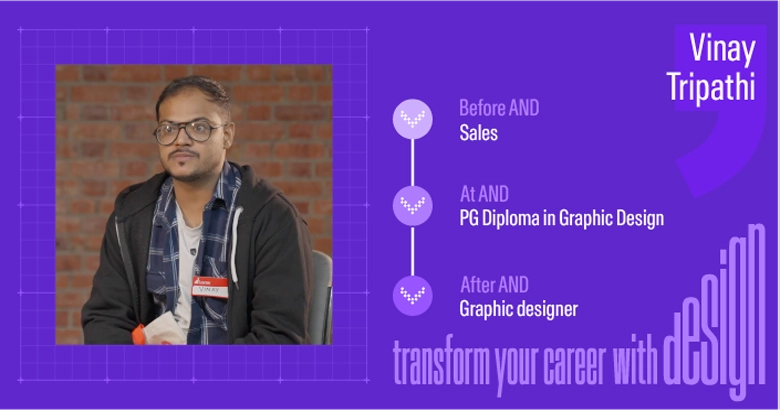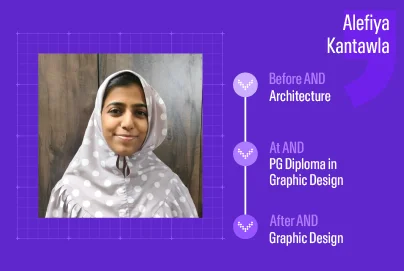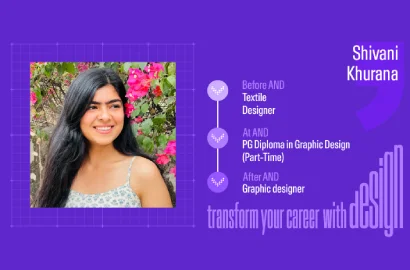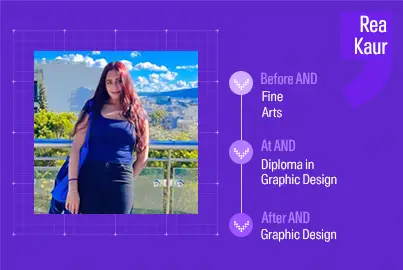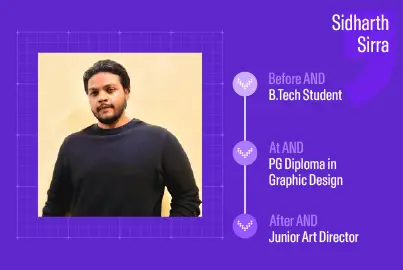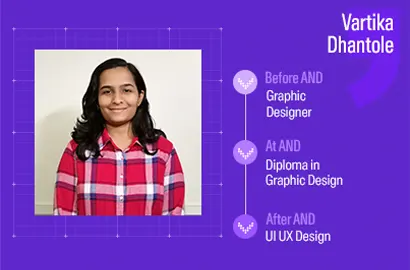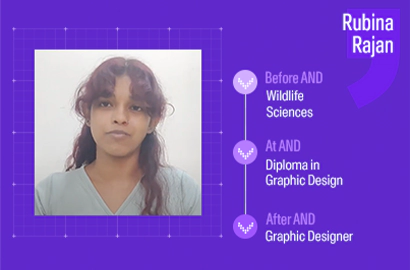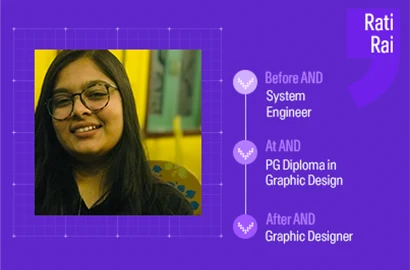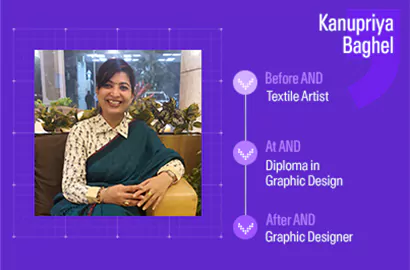In this edition of Student Journey, we will take you through Vinay Tripathi’s transformative journey. Read on to learn more about his experience at AND Academy!
We are back with another exciting student journey where we decode AND Alumni, Vinay Tripathi’s journey from sales to copywriting to finally, Graphic Design! Vinay enrolled in our Part-time PG Diploma in Graphic Design, and in this piece, we’ll take you through his journey and experiences with the course.
Here is a brief overview of everything we talked about!
- Vinay’s background and interests
- How did Vinay discover his interest in Design
- How did he discover AND Academy
- Vinay’s type-based poster project
- Vinay’s brochure project
- His biggest challenges and learnings
- Aspects of AND that impacted him the most
- Vinay’s current career aspirations
- His advice to future learners
- Would he recommend AND Academy to his friends and peers
Q1. Let’s start with you telling us about yourself. Would you like to share your background and interests?
Hello, my name is Vinay Tripathi. My educational background is in commerce, and I graduated with a B.Com from Prahladrai Dalmia Lions College in Mumbai. After graduation, I started a period of self-exploration, figuring out what to do and what not to do. That’s when I found that design is my interest and passion.
Apart from design, I am also very interested in writing, be it content, songs, or poems. Reading is another passion of mine, especially philosophical books. I also have an interest in science and technology, mainly in exploring and understanding how things work.
It is great to know you have such varied interests.
Q2. So, how did you discover your interest in Design? What made you decide this is what you want to do?
My design journey wasn’t linear; it was a journey of self-exploration. I discovered my interest in graphic design around 2022. Until then, I worked in the sales industry as a relationship manager. After that, I found my interest in copywriting, and that is what ultimately brought me to design.
When I was in sales, I loved to reach out and converse with people about business, but that was one-to-one. Then I transitioned to copywriting, where I was meeting one-to-many through words. But I soon realized it’s not just about words; it’s about visuals too. It’s important to connect your written content with the right visual. That was the challenge I was facing. I could write content, but I wasn’t sure how to attach the right image to it. The idea of a brand identity wasn’t even in my mind back then.
The shift to design happened while I was working with a client. My content was good, but the client said that my design was not very premium. It didn’t feel premium. They said that if I were to go into the market with that design, nobody would consider me to work with them. That was an eye-opener for me. After this experience, I started searching for graphic design courses. I realised that if I want to make it in this industry, I need to upskill and improve my designs. And that’s how I discovered I want to pursue design as a career.
That’s an interesting journey!
Q3. So, how did you discover AND Academy, and what made you enroll in the Graphic Design PG Diploma course?
When I first realised my interest, my intention was to explore and understand visual communication and the whole world of graphic design. That’s what I was searching for when I eventually landed at AND Academy during my research. The moment I visited the website, I realised that all of this is not just about visual communication design, it is also about branding, brand identity, etc. I realised there is so much to learn, even motion graphics!
I figured AND teaches everything I need to know to enhance my skill set. It also connected very well to the copywriting aspect of my career. The curriculum was really comprehensive and offered me everything essential to becoming a graphic designer. It was everything I was looking for, so I just decided to go for the course, and it was a great decision! It gave me knowledge and a willingness to keep exploring and upskilling myself.
We are so glad you joined AND!
Q4. Now, let’s talk about your projects. We’ve heard great things about your type-based poster. Can you describe your concept and design process to us?
Yes, the type-based poster was the first project I created during my time at AND Academy. The design brief was that the type had to be the hero, and my chosen keyword was “silent.” The goal of this project was to understand my “why”- like, why I chose this word and what I wanted to tell the world through it.
My initial approach was a step-by-step process. First was the exploration part, where I did “crazy eights” to generate a lot of ideas. Then we shifted to the idea development, where I used tools like Illustrator to further improve my initial concepts.
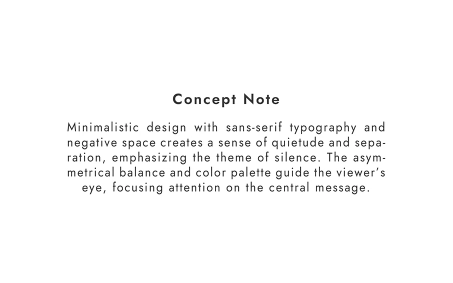
Concept Note
A key part of the brief was that we had to print our designs as well. Before that, I had no experience with print posters. This was my first experience. After generating the design, I went to the market and had a black and white Xerox made.
The parameter that my mentor gave me to judge my design was based on why I did what I did. This was the main thing, and it still is. It’s what differentiates a great designer from an average one. The design choices you make, the reason behind them, and the story behind why you make that decision.
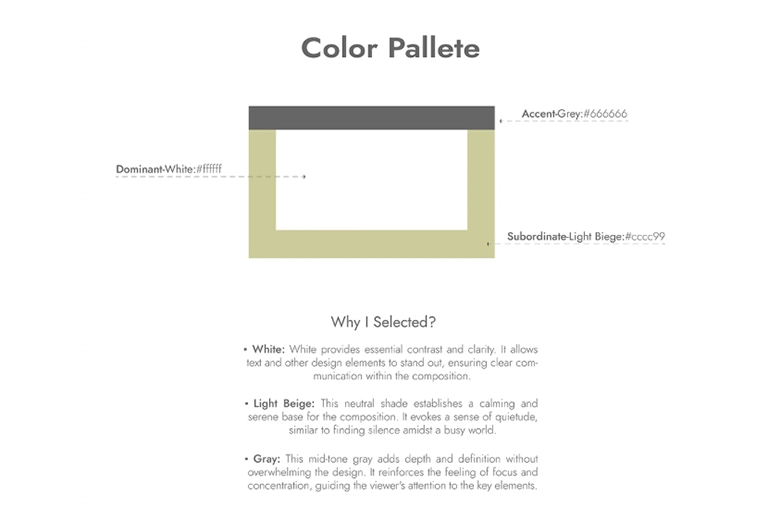
Color Palette of the Poster
Next, we move to the color exploration part. I tried different color combinations. Then, we moved on to the part where I explained why I did what I did and the techniques I used in my poster. Finally, we started working on refining the design. The process to select one out of the many I have designed was a challenge. As it was my first experience, deciding which concept to finalize was difficult.
The final poster I selected was one that best communicated my intended message. Visually, it aligns with what I want to convey. It’s like silence is divided into two halves. It felt like I was saying that in the world of continuous hustle and bustle, we need some silence. And silence is where we can introspect and connect with ourselves to find out who we really are, what we want, or make the main decisions in our lives. It’s in silence that these things happen.
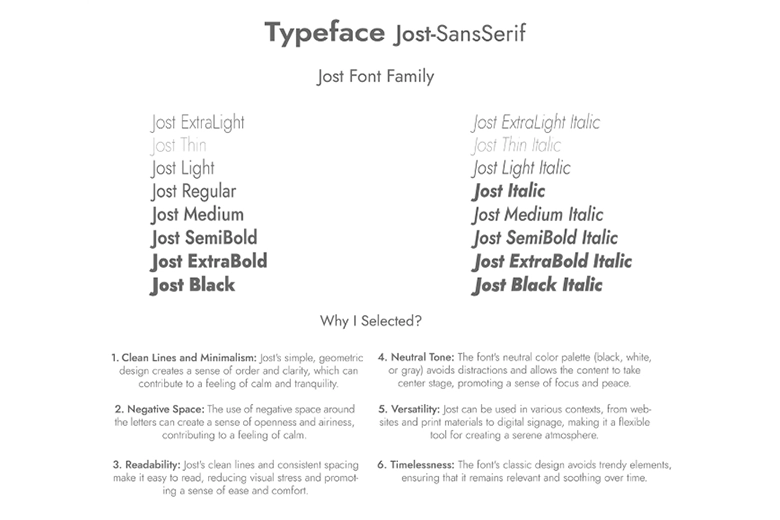
Process of selecting Typography for the poster
The asymmetrical alignment of my poster also aligns with this thought. It represents the need to create a gap between us and a society that is so demanding, where we are continuously working and burning out. I wanted to portray the importance of taking a pause and some time for ourselves. That was the core idea behind the final poster.
The whole process was about iterations. I created a lot of variations. The feedback from my mentors was very helpful. I always received timely feedback to improve my work. I appreciated it especially since I sometimes couldn’t attend lectures due to my work schedule. At moments when I wasn’t sure which direction to go in, my mentor was always there to guide me.
For instance, my mentor pointed out that one of my concepts wasn’t aligning with the brief because the project was about using only typography, not icons, and I had created some icons.
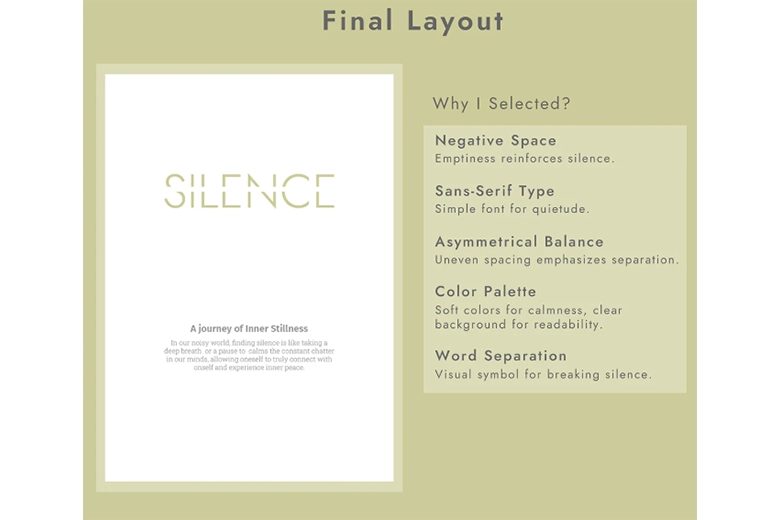
Final layout
So, I had to rework it, creating multiple new variations. This process was quite exhaustive. Like, you think you have an outcome, but you have to take a step back, reiterate, move forward, and learn again. But that’s where the beautiful things happen. The outcome comes when you create multiple options and, with proper feedback, choose the direction you want to take. I think that’s the best lesson I learnt from this experience.
You had a great thought process while creating this project!
Q5. You also worked on a brochure project. Can you describe that, your research process, and how you developed the design?
Yes, the brochure project was about Moonj Basketry, a craft that is practiced in UP and Bihar. We had to take inspiration from a craft and create a brochure design. So, I chose this one.
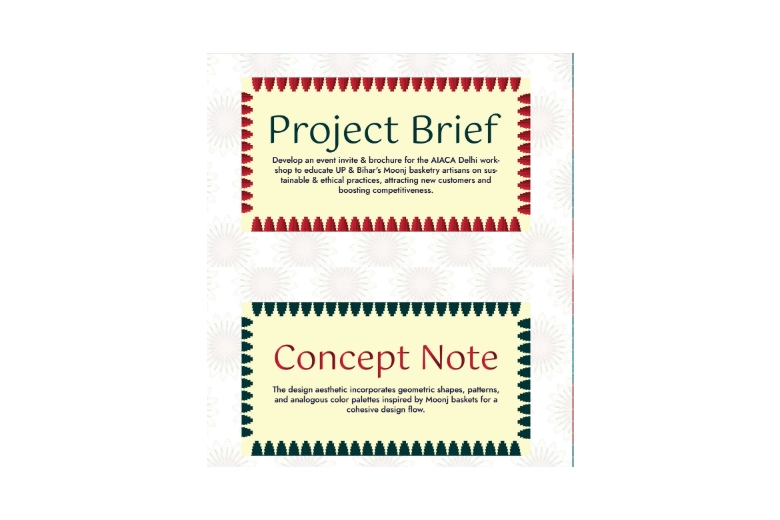
Project Brief and Concept Note
The process started with an extensive background study. I researched all aspects of the craft, its origin, evolution, where it’s practiced, how and why it started, its current state, how it is made, etc. So, these baskets are mainly made of Moonj and Kaasa grass in Prayagraj, Uttar Pradesh. It’s a craft that has been practiced by my mother’s family as well. I also researched how it is sold and the current state of the product in the market.
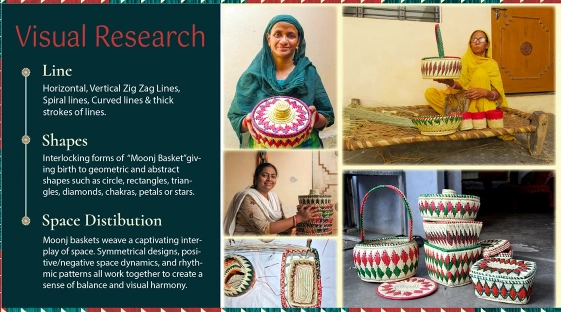
Visual Research
I had to note down the entire process, from harvesting and processing the Moonj grass to the final basket construction, from raw material preparation to sun-drying. It was an extensive study. A key learning here was how to use credible sources for research. You can’t just use any website for information. It’s important to choose the right kind of credible sources to make your background study robust.
Then came the visual research and my own observation. What kind of lines are in a Moonj basket? What kind of shapes? What colors do they use? What are the overall themes? It’s mostly geometric shapes, is what I learnt. I studied how balance and harmony work in the basketry, its symmetrical nature, the use of positive and negative space, the patterns, and the unity. The visual flow of a Moonj basket is from the center, going outward, like a spiral. From this visual exploration, I extracted graphic elements.
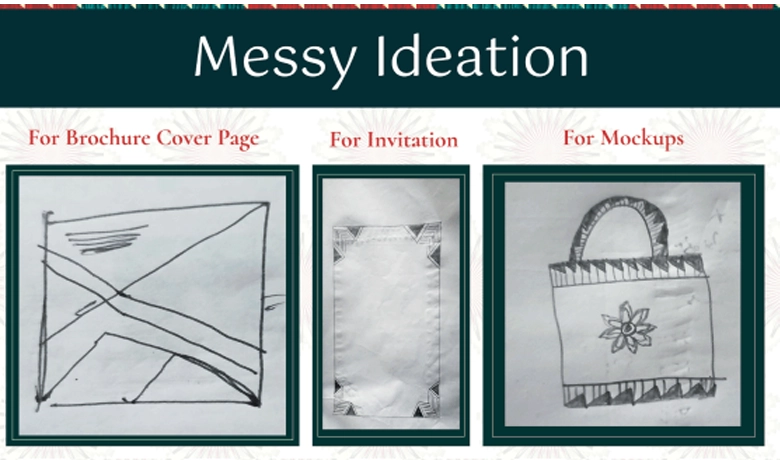
Messy Ideations
I organized all this research into a mind map to get a clear overview. Based on this, I started the ideation process. We were encouraged to do a lot of messy ideation, and I generated eight ideas for the brochure and eight for an invitation. After that, I moved to color exploration and extracted a color palette. My first outcome was a very basic invite, and I received feedback that it wasn’t aligning with what I wanted it to be. It was very normal and not persuasive enough to make someone buy the basket.
So, after that, I worked on defining the font style, color, and extracting the key elements. We used the Design Inception worksheet to decide on the mood, feel, and personality of the project, which helped guide our final design decisions. I created different variations of brochures and even printed them out to test the legibility and proportion of the text.
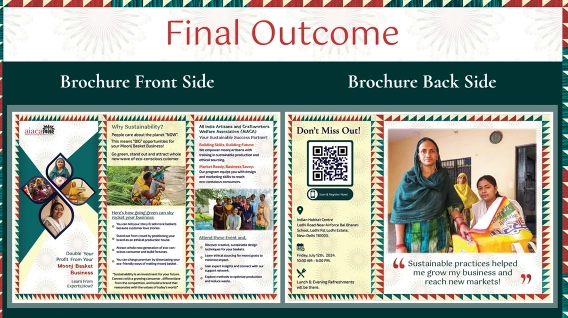
Final Brochure
Finally, I put all the content together, from the front cover to the inner pages, and refined the layout. I also tested the final result on different paper types, like matte and glossy, to see the effect. In the end, it came out really nice and exactly how I wanted it!
The research and work you put in are really commendable!
Q6. What were the biggest challenges of working on these projects? Also, what were the major learnings you gained through this experience?
The biggest challenge was learning how to do in-depth background research. As I mentioned, for the Moonj Basketry project, the research was extensive. Initially, that was a lot of work. As someone who just got into design, I didn’t know much about the importance of research. But, now I’ve learnt that it is the foundation that builds the context of the design.
Also, I learnt that presentation skills are essential. It’s not just about doing the work, but also about showing up confidently and sharing your work. Initially, I was not confident about switching on my camera in class. I used to switch the camera to my work desk, but later, I realised how important it was. Switching on the camera and communicating with the mentor in real-time helped me grow so much. It is so important to show up. Speaking about our work and taking feedback helps a lot. It also taught me not to hide from criticism.
I also gained a lot of knowledge. I now understand design processes and design thinking much better. I can now make conscious choices when it comes to typography, colors, imagery, and layouts. I also understand graphic design principles, Gestalt principles, etc., very well.
Nowadays, when I see any brand, I devote two to three hours to decoding their brand strategy. I try to understand why they are doing what they are doing, what their communication style is, and why they made certain design choices.
My communication skills have also improved. It has made me gain a lot of confidence. Now that I have learnt so much at AND Academy, I feel ready to work with clients and interact with them confidently. There were many challenges, but I think the learning trumps them all.
Your focus on learning and not challenges is really inspiring!
Q7. So, now, let’s talk about the most impactful aspects of your learning and experience at AND Academy.
First, I would say I had a great experience with the classes. They were quite interactive. The mentors and the overall support system were also very impactful. The onboarding experience was awesome. I had a counselor discussion, which was more like an interview. The mentor asked the reason behind my decision to join the course. It wasn’t just about exploration; it was about making a conscious decision and being serious about what you are doing. The transparency was there from the first day. The guiding person before my onboarding was very transparent, and that experience has been really good till now.
Finally, the curriculum itself. The way it’s structured, with things like the Design Inception Sheet and a focus on process, has been excellent. It gave me the confidence to work on any project because I now understand the fundamentals.
We are really glad to learn about this aspect of your experience.
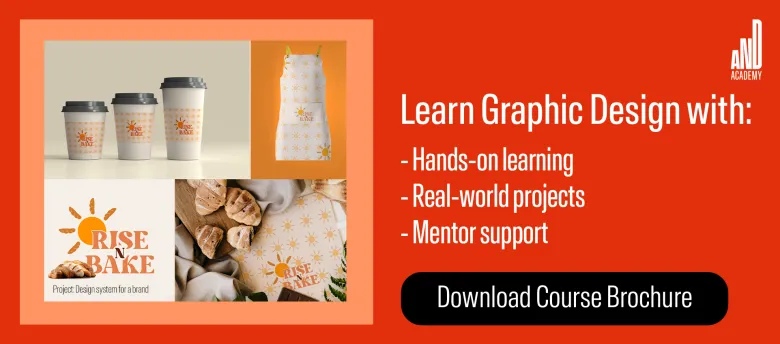
Q8. So, what are your current career aspirations like?
My long-term vision is to redefine brand storytelling. I want to design AI and immersive experiences, eventually building a disruptive creative agency. I’m still working towards it, but that’s the grand plan.
For now, my goal is to become a creative designer or creative director. I want to work in a role where I can make all the choices about the design and decide the direction in which it will go.
You have some really grand plans!
Q9. If you were to give advice to someone starting a similar journey to yours, what would it be?
My first advice would be to be clear on why you are joining AND Academy. You can’t take it casually, as you will have to give your 100%. If you are not clear on why you are joining or why you want to pursue graphic design, you might end up feeling very overwhelmed.
So, that’s the main thing. And after that, if you’ve started, don’t stop. Even if you feel you’re not making progress, or your designs aren’t looking that great, or you’re not able to communicate your thought process clearly, you have to give yourself time. Once time passes, with each module, you’ll find you can express more. In the beginning, I wasn’t sure about so many things, but now I can see a visual and decode it. I can understand what a triangle shape is saying and what a circular shape is conveying. These are the things you will learn once you join and stick with AND Academy until you reach your goal.
That’s really wise advice!
10. Lastly, would you recommend AND Academy to your friends and peers who want to start their journey in Graphic Design?
Definitely, 100%! In fact, I already do!
Really glad to know that, Vinay! And with that, it’s a wrap! Thank you so much for taking the time to have this conversation with us today. We are glad the course was a transformative experience for you and helped you gain crucial graphic design skills. We wish you all the best for your future endeavors!
Are you feeling motivated after reading Vinay’s journey? Then, don’t think much and explore our range of flexible and stackable Graphic Design courses at AND Academy. These courses are perfect for learners of all skill levels. You can start with a Graphic Design Certificate course and progress to a Graphic Design Diploma or PG Diploma to gain more expertise and knowledge. You can even go for a Full-Time PG DIploma in Graphic Design for a more holistic learning experience.
If you have any questions, feel free to reach out to our Course Advisors.
Note: All information and/or data from external sources is believed to be accurate as of the date of publication.

